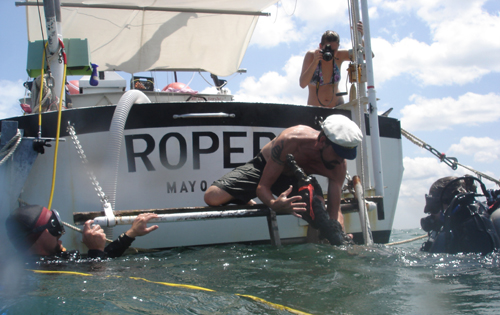
LAMP divers raised not one but three muskets from the late 1700s Storm Wreck during the 2012 field season.
What a great article came out of the Jacksonville newspaper, the Florida Times Union, last Saturday. I missed it as I was on vacation, but heard all about it when I came back into the office this week and it is online.
From the Times Union:
In 2009, members of the Lighthouse Archaeological Maritime Program were aboard their research vessel, the Desmond Valdes, doing a remote sensor survey. They got a noticeable magnetic return.
Divers who investivated found a large cast-iron cooking cauldron and other artifacts, and registered the site under the name Storm Wreck.
The students, interns and volunteers of the program’s field school excavated the immediate area in the summer of 2010. That November, LAMP Director Chuck Meide went out to retrieve equipment left behind.
But the sands had shifted.
In addition to the mooring anchors and lines he was expecting, Meide found a cluster of cannons and a bronze ship’s bell — only 10 or 15 feet north of the original site.
A discovery like this is the reason LAMP exists. It was founded as the
archaeological branch of the St. Augustine Lighthouse and Museum. When the lighthouse museum became affiliated with the Smithsonian Institution in 2010, it was time for a name change.
“We decided to re-brand ourselves,” said Kathy Fleming, the group’s executive director.
The First Light Maritime Society was born.
For the record, it was actually LAMP archaeologist Dr. Sam Turner that discovered the cannons and bells that day, not LAMP Director Chuck Meide. But otherwise the article gets its facts straight. The article also spoke to the First Light Maritime Society’s work to promote maritime education in our community:
Mollie Malloy, the director of regional programs, said the society partnered with JaxPort, the Jacksonville Port Authority, to develop a maritime-industry curriculum for the Schools for the Future Academy at The Bridge of Northeast Jacksonville.
Twenty-two eighth-graders took the class from January to May, according to ZoeAnn Boyle, development director for The Bridge.
The course focused on First Coast history and exposed the students to job skills necessary for maritime careers — “Everything from archaeologist to crane operator at the port,” Boyle said.
She said they would like to teach the course again, if they can fit it into their academic schedule.
“They were great partners,” she said.
The society also works with The Bridge to help children from low-income neighborhoods.
“There were kids who had never seen the Atlantic Ocean,” Malloy said. “Their world view is very small. We’re trying to expand it.”

LAMP archaeologists Brendan Burke and Matt Hanks recovering an assortment of concreted artifacts from a single 1 m by 1 m excavation unit on the shipwreck site.
The reporter also mentioned LAMP’s internship program and annual field school, and interviewed two of our students:
LAMP is also involved in education, sponsoring a college internship program since 2007.
This summer’s class of 11 students was the largest to date; it included Olivia McDaniel and Austin Kirkeberg, who both said they found the program by searching the Internet.
McDaniel, a senior anthropology major at the University of Idaho, said LAMP’s field school looked like it offered a good range of experience.
It also accepts a good range of experience, as this is Kirkeberg’s first college class. Originally from Port St. Lucie, he recently completed four years in the Army, and said visiting the ancient city of Babylon while he was in Iraq is what sparked his interest in archaeology.

LAMP archaeologists Brendan Burke and Brian McNamara inspecting a pewter spoon recovered from the Storm Wreck. Two more were discovered this year, bringing the total to six spoons of various styles.
[Executive Director Kathy] Fleming said the society is raising funds and making plans for a new, larger facility. The archaeology branch is currently crammed into three very small buildings.
Fleming said the new building will have large classrooms, a dive locker, offices and the society’s first real laboratory space.
“It’s like looking for clues at a crime scene,” she said. So they could use a lab, like on “CSI,” to properly expose and preserve future discoveries.
Even with the expanded space, Fleming said, they will not bring up everything they find. They only bring up things that will help tell the story — something that may contain a date or information about its country of origin.
Besides being too expensive to bring up and store everything, she said, “We try to leave some things for the next generation of archaeologists.”
As for their current project, the Storm Wreck, will the mystery of its real name and purpose ever be determined? Only time will tell — time … and the ocean.

